Acer Sustainability
Acer has been guided by its mission of breaking barriers between people and technology since day one, and today that mission is as relevant as ever. Acer believes everyone can reach their potential and that technology can help them to do so, such as by making education accessible for disadvantaged groups and rural areas through technology.
“Making the world a better place” is the driving aspiration behind Project Humanity, an initiative involving Acer’s global employees to make a positive impact onto society and the environment. Humanity has always been a core value of Acer, who believes it is its responsibility to reciprocate to society. Through Project Humanity, Acer aims to lift the attention of its employees to the critical issues of environment and education and create solutions together for the next generation.
The first wave of Project Humanity kicked off in 2019 to engage employees to take action in their everyday lives, focusing on reducing single-use cups and bottles at work, collecting electronic products and batteries for closed-loop recycling, and providing educational tools for the underprivileged. Guided by the brand and corporate strategy, Project Humanity acts as a platform that fosters synergy between employees, partners, and stakeholders to drive change.
Acer has long been committed to enhancing energy efficiency.
Our brand values:
"human"
"progressive"
"curious"

In May 2021, The Acer Group announced that it has joined the RE100 initiative and also shared a pledge to achieve 100% renewable energy use by the year 2035. In addition, Acer declared its mission to help tackle environmental challenges with its “Earthion” platform that unites the strengths of its employees and supply chain partners and expands the circle of impact of its sustainability efforts. These strengths and efforts are exemplified by the Aspire Vero notebook, its first sustainability-focused product under the Earthion platform.
“I am so touched to see Acer employees and partners come together, knowing that they have the ability to make decisions to protect our environment for future generations,” said Tiffany Huang, Co-Chief Operating Officer, Acer Inc. “We already have the commitment of AUO, Compal, Innolux and Quanta, and look forward to welcoming more partners to join the Acer Earthion mission to speed up the development of green designs and processes and support our goal of 100% renewable energy for a sustainable planet.”
Acer Product Life Cycle
Management
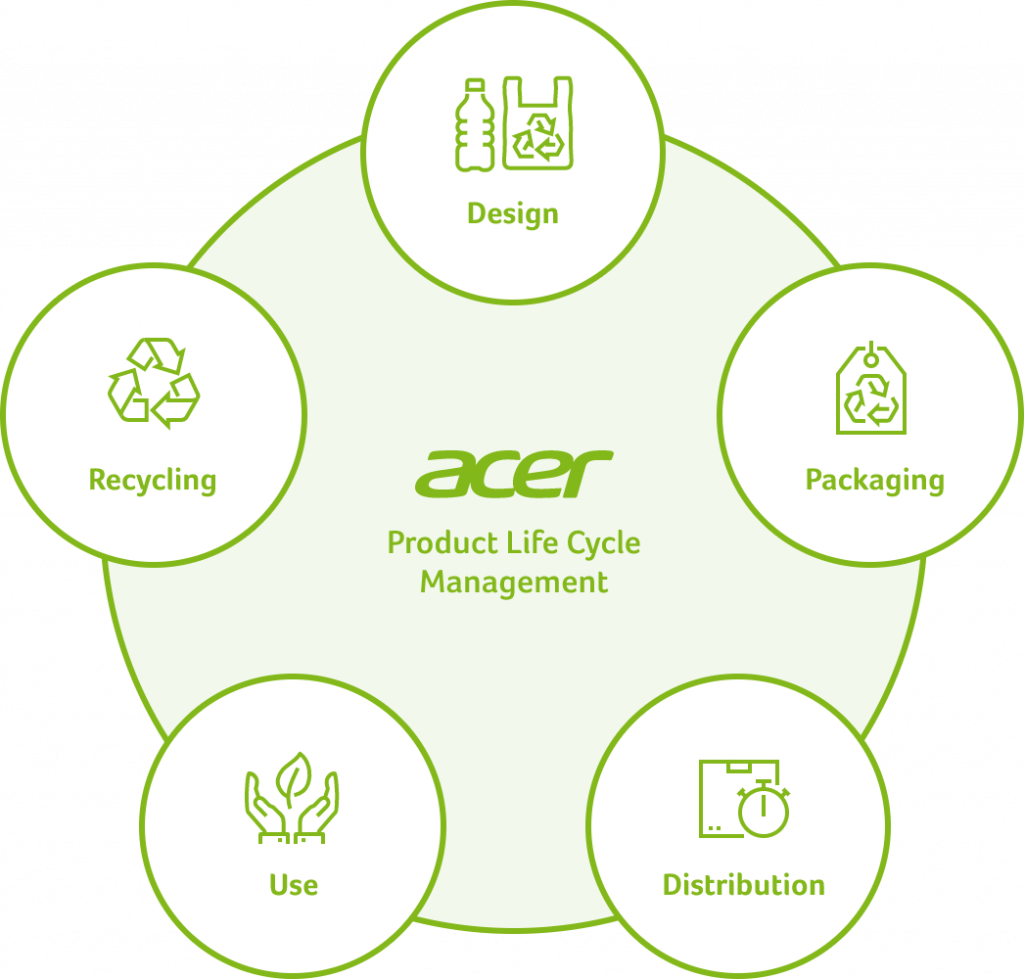
1.
Design
• Use post-consumer recycled plastics
2.
Packaging
• Material reduction in design
• Use environmentally friendly materials
3.
Distribution
• Refine product transportation efficency
4.
Use
• Repair and Refurbish
• Leasing and shared econowy
• Energy saving
5.
Recycling
• Recycle PC and batteries
1.
Design
• Use post-consumer recycled plastics
2.
Packaging
• Material reduction in design
• Use environmentally friendly materials
3.
Distribution
• Refine product transportation efficency

4.
Use
• Repair and Refurbish
• Leasing and shared econowy
• Energy saving
5.
Recycling
• Recycle PC and batteries
Use of Post-Consumer
Recycled Plastics
In 2018, we officially announced our list of chemical substances banned or restricted in manufacturing. Stage 1 includes the following substances: benzene, beryllium dust and fumes, chlorinated organic solvents, n-hexane, N-Methyl-2-pyrrolidone, toluene, and substances harmful to the ozone layer. Effective from 2019, these chemicals will be included in management, and depending on various internal and external conditions, this list will gradually expand to improve the non-toxicity of our product manufacturing processes. We have also included Phthalate Usage Disclosure in our supplier CSR scorecard, encouraging vendors to prioritize the use of phthalate-free materials and further promoting the elimination of phthalates from our products. 2020 also saw us continue to produce product models free of BFRs and PVCs, in particular portions of our commercial notebooks and desktop computers. On top of this, more than 6 million units of phthalate-free products across product lines were shipped, valued at over US$4.1 billion.
8.8 milion +
making use PCRs, accounting for 24,08% of hardware revenues
6 milion +
more than 6 milion units phthalate-free products across product lines were shipped

Acer supports the concept of resource recycling and actively strives to use post-consumer recycled plastics (PCR) in our products. At the same time, with regard to the materials that are most likely to create problems of pollution or occupational safety in the recycling process, we work with plastics manufacturers and upstream recyclers to conform to international standards of quality, environmental safety, occupational health and safety, and responsible recycling (R2), earning international export licenses and recycling service provision qualifications from local governments.
When deciding on machinery and proportion of PCR during the planning of products, we are careful in our selection of plastics suppliers; for new products using PCR, we strive to stay as close as possible to the physical properties of our materials during formulation, in the design process, we focus on improving strength and reliability, and in product testing, we have added stronger tests of strength, reliability, and lifespan to ensure product quality. This means that users can enjoy products made of quality recycled plastics and join Acer in supporting the use of reused or recycled materials.
In 2019, we continued to use recycled plastics in commercial display units and all-in-one computers, including the Band V series of commercial displays and all series of all-in-one desktops. Since 2019, we have been using PCRs with our notebook computer products. In 2020, we again expanded the scope of this effort, with some 8.8 million products making use of PCRs, accounting for 24.08% of hardware revenues, further strengthen our implementation of the concept of circular economies. We also place importance on the issue of marine plastic waste pollution. To this end, we continue to evaluate the use of offshore-recycled plastics in our notebook computer products to raise consumer awareness of this issue.
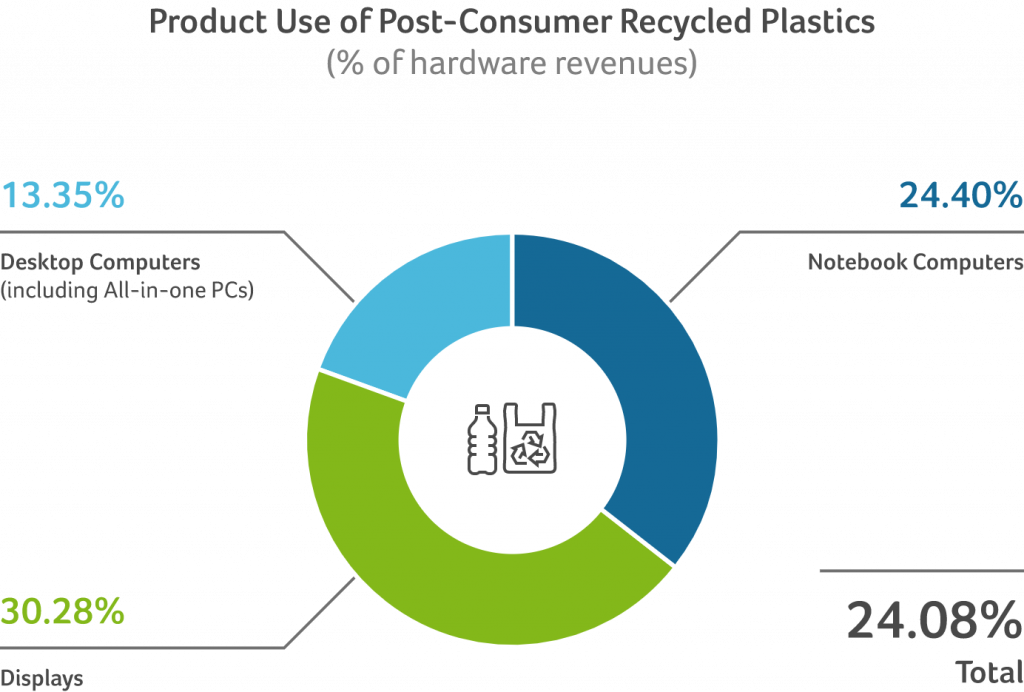
Reduction in design
Acer’s packaging is designed around the concepts of limited resources and suitability, and as such, since 2016, we have been planning reductions in the size of our product boxes and the scale of our packaging. As part of this, we continually work on reducing our usage of iron, plastic, and paper. With regard to reducing packaging for notebook computers:
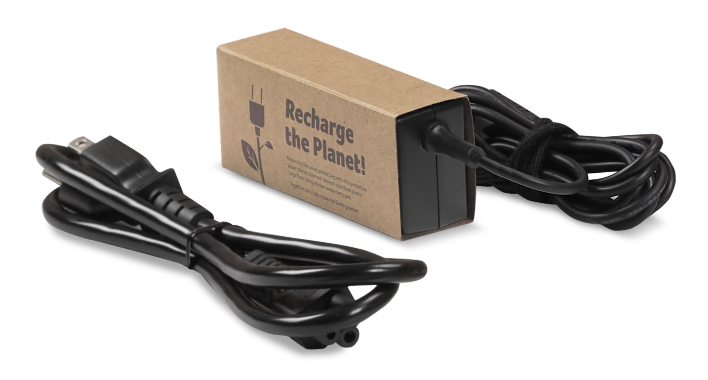
Before
Pre-reduction
Power and charging cables are packed in single-use plastic bags
After
Post-reduction
Plastic bags have been removed from the power and charging cables, replaced with paper sleeves

Use of recycled materials
The vast majority of product packaging becomes waste after it has finished its job of protecting the product(s) within. Acer carefully considers the materials we use in our packaging, with packaging design emphasizing recyclability and making use of easily recyclable materials a priority.
With the exception of the China region, all other regions—Pan America, Asia Pacific, EMEA, and Taiwan—have moved entirely to using recyclable packaging materials for commercial desktop computers, including recycled EPE and molded-pulp packaging. The percentages of molded-pulp packaging and recycled EPE used in our commercial desktop packaging are as follows:
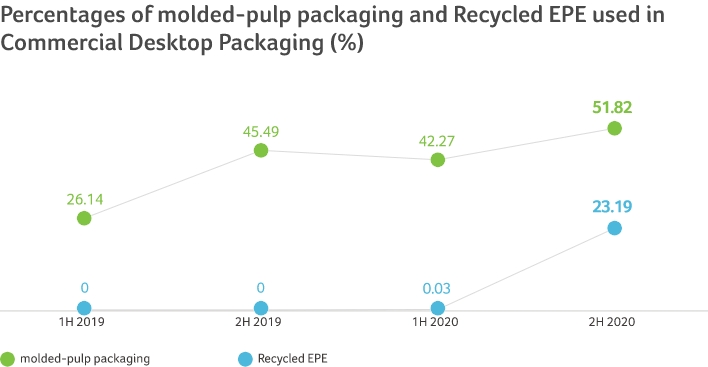
Green packaging

“3Rs” at the foundation
The “reduce, reuse, and recycle” triumvirate is at the core of green design, and through our design approaches, we strive to make the production, shipping, marketing, disposal, recycling, and packaging of our products meet needs for environmental protection and reduce our impact on the environment, further emphasizing the intersection of environmental aw

High percentages of Recycled paper pulp
The packaging for the ConceptD series uses 90%+ recycled paper pulp in the production of recyclable materials, thus reducing the consumption of natural resources.

Free of plastics
Integrating environmental considerations and actions to prevent pollution into our design efforts, we use recycled paper with ingenious structural design to eliminate the use of plastics in our packaging.

Using recycled materials
We analyze each component of our packaging for reuse potential as a fundamental part of the functionality of that packaging. By incorporating recycled materials in our designs, we make those components more reusable, extending their usable lives and doing what we can to lighten the bur
Printing with soy ink
The packaging for the Aspire Vero series is printed with high-purity soy ink, eschewing the usual coating process of traditional packaging design. This simplifies the recycling process, as degumming, deinking, and bleaching processes can pollute the environment. As a result, we accomplish true recyclability and reusability

Acer local activities
Acer UK has partnered with PX3, an IT specialist company whose mission is “to measure and help reduce commercial IT related emissions through the diffusion of sustainable IT.”
PX3 conducted a market wide survey across 250 decision makers within the UK service sector.
Key learnings
Overall, 90% flagged emissions reduction as important and 67% said emissions reduction was included in their corporate ESG / CSR strategies, strongest in large, private sector organisations.
95% of respondents would find accurate GHG emissions information about devices useful, with nearly 55% rating this information “very useful”.
87% of respondents would be interested in “carbon-neutral” devices, with the same percentage finding the carbon footprint of trade-in devices useful.

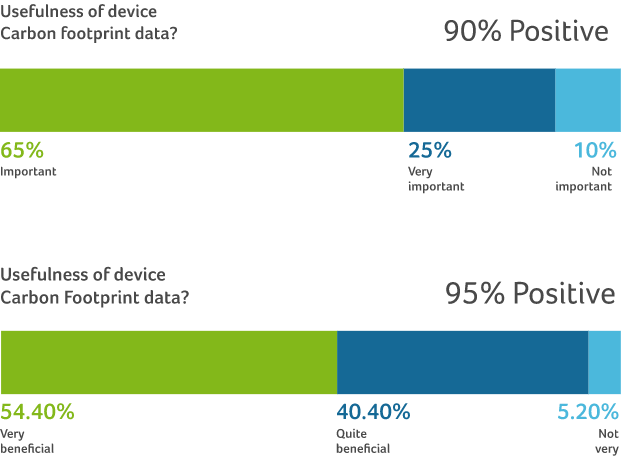
A Greener Acer
Globally, Acer has been working hard to become a more sustainable company.
With a pledge to achieve 100% percent renewable energy use by the year 2035, there have been many green innovations in product design, using less packaging and more recycled materials in packaging design, minimizing the impact of production on the environment, developing a smaller carbon footprint from logistics, and recycling, reusing, and repurposing resources.
The Acer Green Rewards System
Acer Green Rewards is a dedicated on-line portal and deal calculator that enables resellers the tool to instantly deliver new product quotes, provide recycle trade-in values, present added value offers available on Acer product lines and a customised sustainability impact report, all via a single platform, all within a few minutes.
Until now, this combination has never been possible, previously requiring numerous conversations over a significant period of time.
Key benefits
• > Unique ability to integrate recycle rewards into sales conversation – live!
• > Additional top-up rewards on selected Acer products – only available through programme participation,
• > Product detail information integrated within the portal to support sales conversation,
• > Sustainability tool/calculator – Carbon Impact Calculations and Offsetting – WIP (Px3 backed),
• > ATL marketing to generate traffic and leads for participating partners,
• > Co-marketing support for partners to target customers, enhanced with data enrichment resulting in warm intent lead generation,
• > Ability for partners to view pipeline of Acer Workplace Reward deals through the portal,
• > Deals when submitted and approved locked to partner for 2 weeks (but still valid for 90 days),
• > Simple claim process for customers, with no drain on partners – i.e. direct between the customer and Consenna/portal,
• > Full revenue recognition with direct to end-user rewards maintaining full basket value for partner revenue.
Acer global activities
“Environment – We are at a critical moment in the future of our planet. Acer is dedicated to protecting the environment, and this commitment is in our product innovation, how we optimize resources, and why we engage employees to do more for our Earth”
What we have done
• Total emissions in 2020 were reduced by 62%*
• More than 6 million phthalate-free products were shipped,
• More than 8.8 million making use of PCRs, accounting for 24.08% of hardware revenues
• Single product use plastics have been removed from packaging, and now 89% of all
• Acer laptops shipped are packed with recycled paper moulds,
• * compared with the baseline year (2009)
What we will do
• 100% renewable energy use by the year 2035.
• By 2025 20-30% PCRs plastic content in core products.
• 45% reduction in average personal computer 45 % energy consumption (2016-2025)
• 80% of critical suppliers committed to RE100
• 80% reduction of carbon emissions by 2050.
